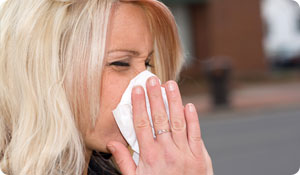
Got a stuffy nose or headache? Perhaps you're also very congested and have lots of mucus when you sneeze or blow your nose. While such symptoms can make you feel quite miserable, they're also very non-specific. As a result, you could be left wondering if they're caused by a cold or by an allergy.
When it comes to cold and allergy symptoms, it can often be difficult tell the difference. The heaviness and pressure that typically in your nasal passages, along with the ache in your throat and chest, can occur with either ailment. Further complicating the diagnosis is that these can also be signs of a sinus infection as well.
But while colds and allergies, and even sinusitis, can look and feel somewhat similar, one of the best signs to help you narrow in on what you have, and how to treat it, is by paying attention to your mucus color and learning about what it means.
Mucus Color Facts
You probably don't think much about mucus--at least not more than you have to--but everyone actually produces this substance inside their nose, even when they aren't suffering from a cold or allergies. In fact, healthy mucus is just a thin clear fluid that works to keep the nasal passages free of foreign particles from the air, such as dust, pollen, and viruses.
Under ideal circumstances, the mucus will trap these invaders and will drip down your throat and be washed away without you even noticing its presence. However, when your nose becomes inflamed, either as the result of allergies or illness, more mucus is formed and it thickens and becomes a light yellow color, which isn't as easy to drain. Suddenly you'll become aware of its existence. It may also drip down the back of your throat (often referred to as post nasal drip) and may cause you to cough. Sometimes the mucus may also become thicker and sticky. This can be caused either by very dry air that prevents the lining of your nose from being able to moisten the mucus, or from a bacterial infection that occurs when the mucus is trapped inside and can't be released on its own. Once an infection sets in, the mucus color may take on a darker yellow or green tinge. Sometimes this is accompanies by a bad smell or taste to the mucus, too. When this occurs, you'll often experience a severe headache from the blocked sinus passages and a feeling of being unwell.
When Mucus Color Changes
If you notice that the appearance of your mucus color has darkened or changed and you've been suffering from cold symptoms that won't seem to go away, or you find yourself with a persistent headache or pain, it's probably time to see your doctor to have your symptoms evaluated. If you it turns out you do have a sinus infection, you may need an antibiotic to clear it up. A decongestant and/or antihistamine can also to help relieve the pressure and congestion quickly.
Be Proactive
The best way to treat a sinus infection is to avoid getting one in the first place. This can be done by controlling your allergies through a combination of medicine and environmental changes in order keep your nasal passages clear and help your mucus flow well. You can also pay attention to the mold and pollen counts and stay inside when they're particularly high. By recognizing your symptoms and trying to head them off whenever you can, you can forget about your mucus color and focus on other things.
Sources
Allergy and Asthma Foundation of America (AAFA)
http://www.aafa.org/display.cfm?id=9&sub=16&cont=66
ENT Associates of Corpus Christi





